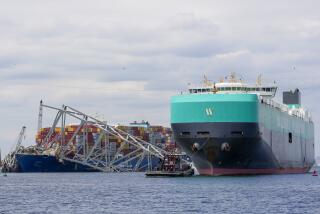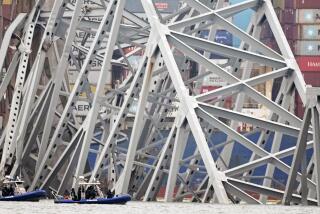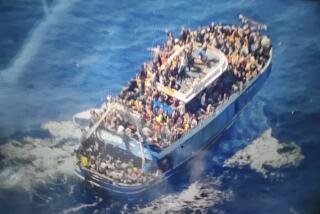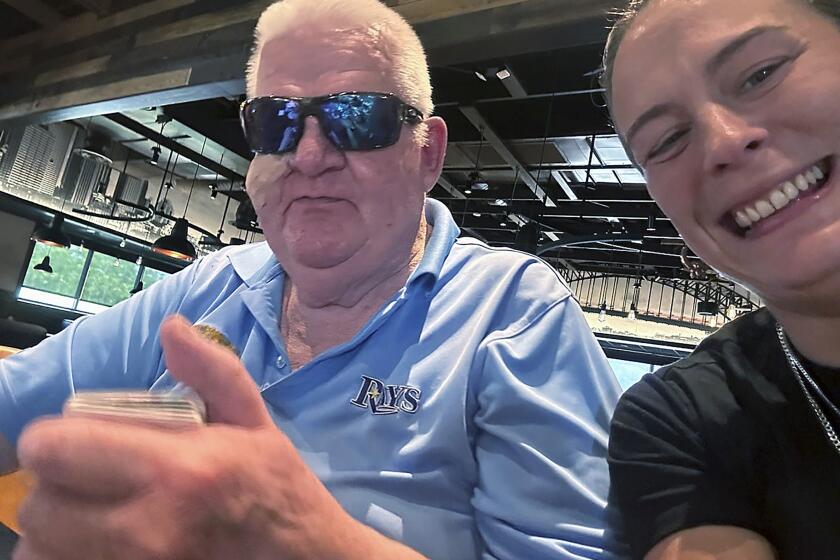200 Feared Dead After Ferry Capsizes Outside Belgian Port : 202 Rescued From Icy Sea; Cause Unclear
ZEEBRUGGE, Belgium — A British car ferry capsized off this Belgian port Friday night with about 550 persons aboard, and early today more than 200 were still missing in the near freezing waters of the North Sea.
“We know of at least 20 dead. Two hundred and two have been certified safe, of whom 97 are in the hospital,” the British ambassador to Belgium, Peter Petrie, said.
“I fear the dead could be in the hundreds, perhaps 200,” said Belgian Transport Minister Herman de Croo, who was coordinating the rescue operation.
The ferry, the Herald of Free Enterprise, operated by the Townsend-Thoresen Lines, had just cleared the port shortly before 8 p.m. on the way to the British port of Dover when it capsized in relatively shallow water about a mile from the harbor, resting on its side.
Car Doors May Have Opened
Port officials were not certain what caused the disaster, in clear weather and calm seas, but speculated that the car doors on either the bow or stern of the ferry may have inadvertently opened, causing sea water to rush in and sink the vessel.
Ferry officials said that the 8,000-ton ship carried 460 passengers and 80 crew members. Because of the cold weather, many of the passengers were believed to have been inside the vessel when it sank.
The scene at Zeebrugge was eerie throughout the night with floodlights illuminating the port and the nearby naval base, which served as the rescue center, while helicopters roared continuously overhead, their lights blinking in the darkness.
From the sea wall guarding the port, onlookers could see the helicopters as well as a dozen ships involved in attempting to rescue stricken passengers and crew members. Hundreds gathered under a hazy half-moon sky to watch the rescue work.
Divers Rescue 3 Passengers
At 4 a.m., divers working on the overturned hull rescued three passengers who were put aboard helicopters. But at the same time, a tug boat entered the port with several bodies of victims under blankets.
One salvage expert said that people trapped inside the hull might be able to survive because there were air pockets--as long as they didn’t succumb to the icy waters--about 40 degrees Fahrenheit.
One British survivor, Rosina Summerfield, wept as she said: “My boyfriend . . . I can’t find him. I am not hurt myself, but my little boy’s arm is very bad.
“All of a sudden there was a crash and the boat fell sideways,” she continued. “We thought it was going to correct itself, but it just fell further and further until it was completely on its side. There were people screaming and shouting.
“The lights went out and all you could hear was the water coming in the side that sunk and everywhere there were people floating about,” she said. “Everybody just scrambled.”
Waited 20 Minutes
Summerfield said that she and her son were rescued after waiting 20 minutes on a dark stairway as water poured in.
Another British survivor, Wayne McKenny, 15, from Hastings, England, said, “I’ve lost my mom, I don’t know what happened to her.”
Young McKenny said he escaped by smashing lower-deck windows and then clambering up a rope thrown to him from an upper deck.
“There was lots of screaming and crying after the crash,” he said.
Wrapped in a blanket but still shuddering, the youth said he and his family were just starting to eat in the cafeteria when the ship tipped over.
His father, Richard McKenny, 65, said: “We were very lucky the boat was so close to shore. If it had been further out, that would have been it.”
Bodies Everywhere
A Belgian naval commander at the scene, Jacques Thas, said: “Dead bodies are on the bridge, on the side and in different cabins.”
William Budd, the captain of British freighter Taymar, one of the rescue ships, told a radio interviewer that the ferry was in worse condition when he went back to help a second time.
“It’s rolled over more since I was here last,” Budd said. “I’d say the ship’s definitely in a worse condition. The propellers are out of the water, I can see the bottom of the ship.”
Many of the rescued were treated for fractures, serious bruises, shock and hypothermia. A hospital spokesman in nearby Brugges said that many of the 55 survivors being treated there were children and most were British.
Participating in the rescue operations were teams from Belgium, Britain, Holland and France.
Distress Signal
The Zeebrugge harbor master said the vessel did not send an SOS call, but French rescue officials on the Normandy Coast reported a distress call to other boats in the area for immediate assistance.
The ferry, based in Dover, was seven years old. It addition to passengers and cars, it was designed to transport large trucks and freight.
Among those who rushed to the disaster scene was Belgian Prime Minister Wilfried Martens, who described the accident as “a catastrophe.”
Belgian sailors reported that King Baudouin I had arrived at the Zeebrugge naval base.
The marketing director of Townsend-Thoresen, Brian Thompson, said emergency telephone lines were being established for use of families and friends of passengers.
“We’re all very, very disturbed as you can imagine,” he said. “We all hope dearly that everyone is a survivor.”
More to Read
Sign up for Essential California
The most important California stories and recommendations in your inbox every morning.
You may occasionally receive promotional content from the Los Angeles Times.










